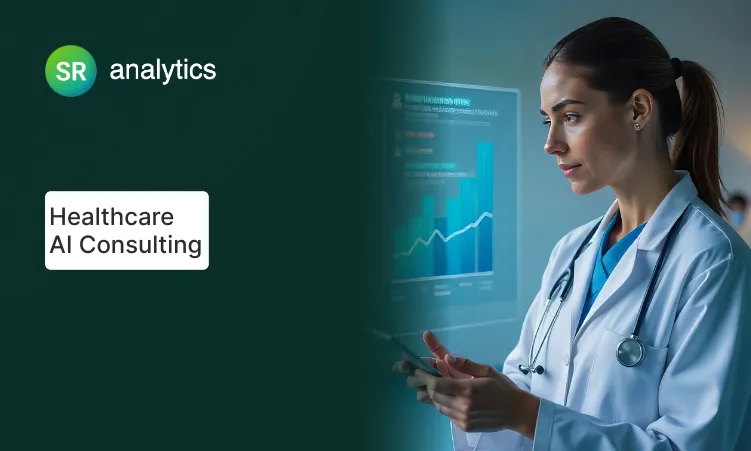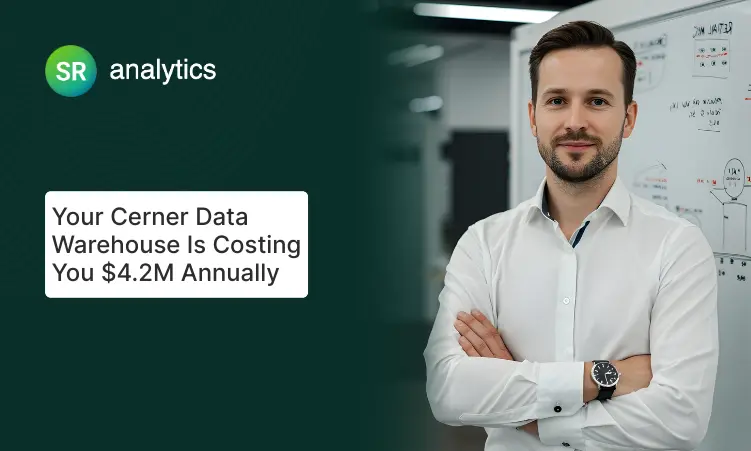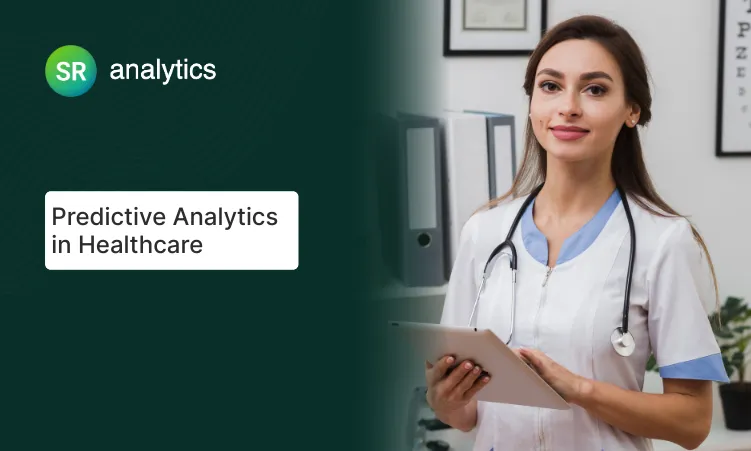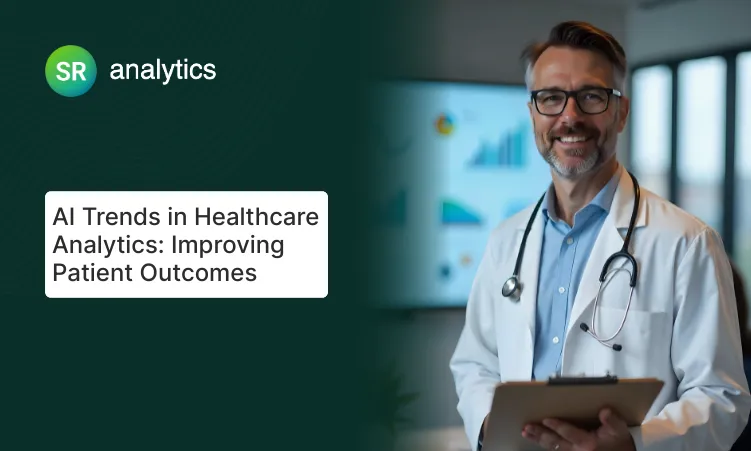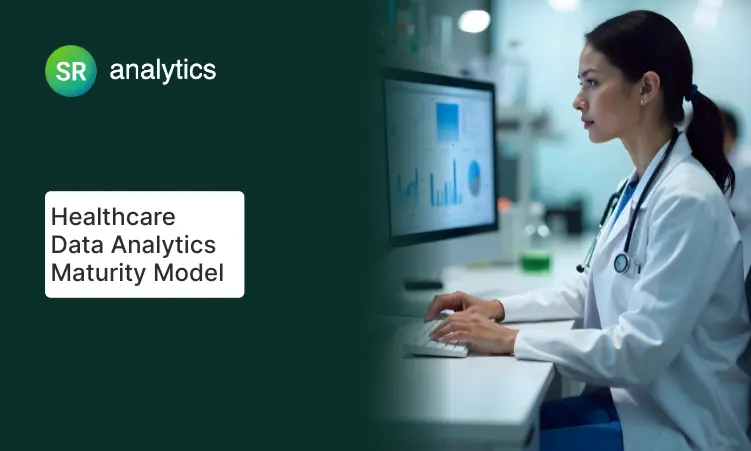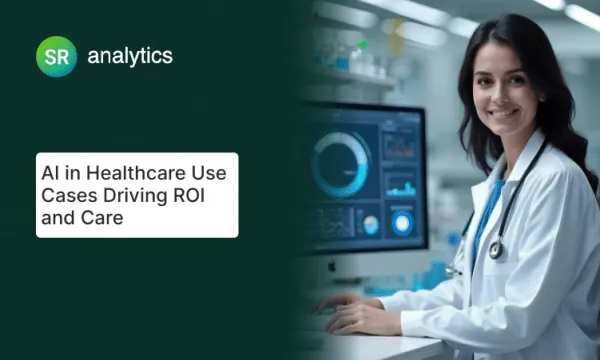Highlights
- Healthcare data analytics has reduced emergency room overcrowding by 18% and improved patient flow efficiency by 30%
- AI diagnostic systems now achieve over 90% accuracy in detecting diseases like diabetic retinopathy and skin cancer
- Predictive analytics can identify sepsis risk 4-6 hours earlier than traditional methods, reducing deaths by 18%
- Custom AI solutions for healthcare are enabling 40% fewer hospitalizations for chronic disease patients
- AI-powered administrative automation reduces physician documentation time by up to 60%
What if you could predict a deadly emergency hours before it strikes, automate half your paperwork, and personalize every patient’s care—today? Discover how data and AI are quietly transforming healthcare from the inside out.
Three years ago, I watched a cardiologist at Johns Hopkins stare at a patient monitor, puzzled by vital signs that seemed normal but felt wrong. Today, that same hospital uses an AI system that would have immediately flagged the subtle pattern leading to the cardiac event we barely prevented.
That moment changed how I think about healthcare technology. It wasn’t just about faster computers or prettier dashboards—it was about augmenting human expertise to save lives in ways we never thought possible.
Last month, that same AI algorithm spotted a pattern in patient vital signs that emergency room doctors had missed. Within 48 hours of implementing the system’s recommendations, they prevented three cardiac events that could have been fatal.
According to a real-time study published in Nature Medicine[1], Johns Hopkins’ TREWS system has reduced sepsis-related deaths by 18% and shortened hospital stays by 1.5 days on average.
In my work with healthcare organizations over the past decade, I’ve witnessed the most significant transformation in healthcare since the discovery of antibiotics. From predictive analytics in healthcare that anticipate diseases to AI-driven healthcare analytics services that cut through administrative burden, data-driven healthcare is becoming the new standard of care.
Here’s what I’ve learned from working with healthcare organizations implementing these technologies: real examples of AI in healthcare improving patient outcomes, practical insights into how healthcare analytics boost operational efficiency, and actionable strategies for successful implementation.
By the end of this guide, you’ll understand exactly how data and AI transforming healthcare—and what it means for patients, providers, and healthcare leaders.
The New Age of Healthcare Data Analytics
Healthcare data analytics refers to systematically analyzing vast health datasets—from electronic health records to wearable sensor data—to extract actionable insights. Meanwhile, artificial intelligence encompasses the algorithms that learn from this data to make predictions, automate processes, and assist in clinical decision-making.
Think of it like this: if traditional healthcare was like navigating with a paper map, modern healthcare analytics is like having GPS with real-time traffic updates, predictive routing, and voice guidance all built in.
Why now? Three converging forces are driving this transformation:
The explosion of health data has reached a tipping point. According to research from the World Economic Forum[2], 97% of biological and health data remains fragmented and inaccessible, representing massive untapped potential for improving care.
Computing power and cloud infrastructure have advanced dramatically. What once required supercomputers can now be accomplished on laptops, making sophisticated analytics accessible to healthcare organizations of all sizes.
The pandemic created urgent demand for remote monitoring, predictive capabilities, and operational efficiency. In my experience working with healthcare systems during COVID-19, those that survived and thrived were those that could rapidly adapt using data-driven insights.
Key areas experiencing transformation include clinical care through enhanced diagnosis and personalized treatment, operational efficiency via optimized workflows and resource management, patient engagement through digital health tools and remote monitoring, and research acceleration in drug discovery and clinical trials.
These healthcare data analytics applications are fundamentally changing how we think about medicine—shifting from reactive treatment to proactive prevention, from one-size-fits-all to personalized care, and from intuition-based to evidence-driven decisions
From Data to Diagnosis: AI for Improved Patient Outcomes
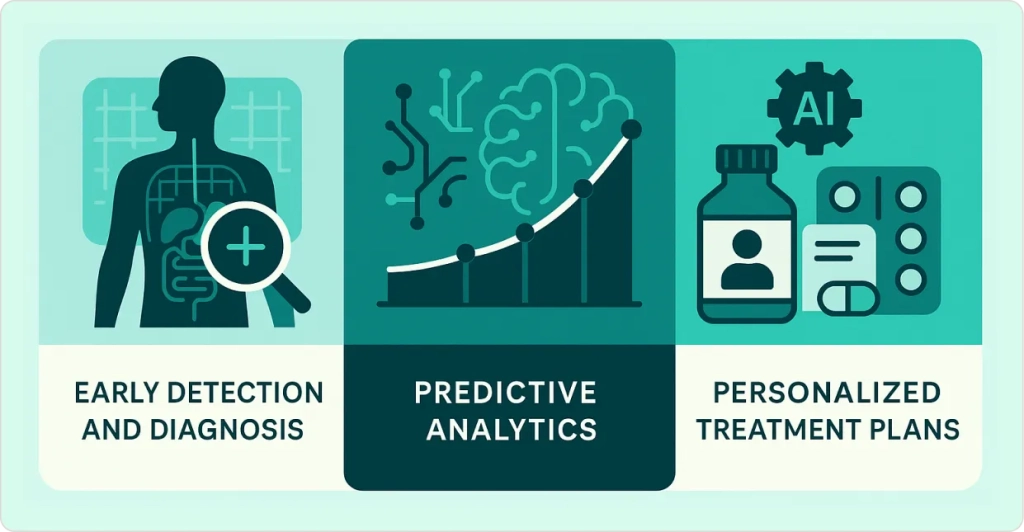
Early Detection and Diagnosis
AI algorithms are revolutionizing diagnostic accuracy by analyzing medical images, lab results, and patient histories faster and sometimes more precisely than human specialists alone.
Google’s diabetic retinopathy screening AI has examined millions of retinal photographs, detecting early signs of vision-threatening disease that could otherwise go unnoticed until significant damage occurs. In clinical trials[3], the system demonstrated over 90% accuracy in identifying referable diabetic retinopathy.
At Stanford Medicine, researchers developed an AI system that analyzes skin lesion photos with dermatologist-level accuracy for detecting skin cancer[4]. The technology could eventually enable smartphone-based skin cancer screening, bringing expert-level diagnosis to underserved communities worldwide.
Here’s what I find remarkable about this transformation: these AI systems don’t replace doctors—they augment human expertise. As one radiologist told me during a recent implementation, “AI gives me a second pair of eyes on every scan, catching details I might miss during a busy shift.”
Predictive Analytics for Preventive Care
Predictive analytics in healthcare enables providers to identify at-risk patients before serious complications develop, fundamentally shifting from reactive to proactive care.
Sepsis prediction represents one of the most impactful applications. Sepsis kills more than 250,000 Americans annually, often because symptoms aren’t recognized early enough. AI systems now analyze patient vitals, lab values, and medical history to flag sepsis risk 4-6 hours earlier than traditional methods, giving clinicians crucial time for life-saving interventions.
Johns Hopkins’ TREWS (Targeted Real-time Early Warning System) demonstrates this power in action. The system continuously monitors patient data and has reduced sepsis-related deaths by 18% and shortened hospital stays by 1.5 days on average.
Readmission prediction helps hospitals identify patients likely to return within 30 days—a key quality metric that affects both patient outcomes and hospital reimbursements. By analyzing factors like medication adherence, social determinants, and clinical indicators, predictive models enable care teams to intervene with additional support, discharge planning, or home health services.
Personalized Treatment Plans
Healthcare analytics enables precision medicine by analyzing genetic data, lifestyle factors, and treatment histories to tailor therapies to individual patients.
Cancer treatment exemplifies this personalization. Memorial Sloan Kettering’s Watson for Oncology analyzes patient-specific factors against vast databases of treatment protocols and outcomes to recommend personalized therapy options. While the technology continues evolving, the principle of data-driven treatment selection is becoming standard practice.
Diabetes management showcases real-time personalization. AI-powered continuous glucose monitors like Dexcom’s G7 don’t just track blood sugar—they predict where levels are heading and recommend insulin adjustments specific to each patient’s patterns, meals, and activities.
One diabetes specialist I worked with shared this insight: “Every patient’s diabetes is unique. AI helps me understand the subtle patterns in their data that would take months to recognize manually. It’s like having a personalized diabetes coach for every patient.”
Streamlining Healthcare Operations with AI
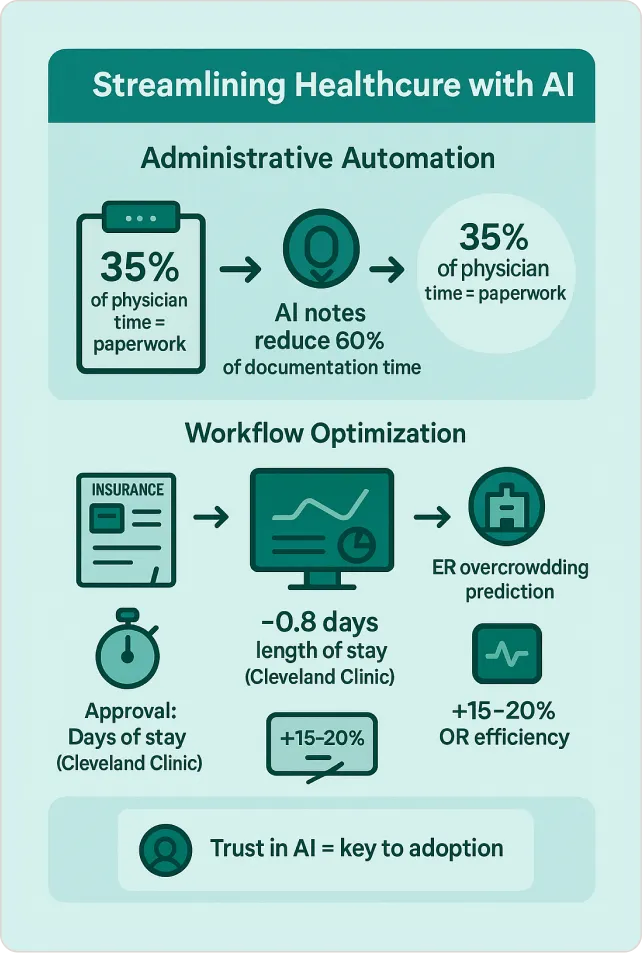
Administrative Automation
Healthcare providers spend enormous resources on administrative tasks that AI can streamline or eliminate entirely. According to the Philips Future Health Index 2024[5], 88% of healthcare leaders say technology is essential for addressing staff shortages, with automation leading the charge.
Clinical documentation represents the biggest opportunity I’ve seen in healthcare efficiency. Physicians spend up to 35% of their time on paperwork rather than patient care. AI-powered scribes like Nuance’s Dragon Medical One listen to patient encounters and automatically generate clinical notes, reducing documentation time by up to 60%.
Dr. Sarah Chen, an emergency physician in California, describes the impact: “Before AI documentation, I’d stay two hours after my shift finishing notes. Now I leave when my shift ends, and the notes are more comprehensive than what I wrote manually.”
Prior authorization automation eliminates one of healthcare’s most frustrating bottlenecks. Insurance companies receive thousands of prior authorization requests daily, many for routine procedures. AI systems can process standard requests instantly while flagging complex cases for human review, reducing approval times from days to minutes.
Workflow and Resource Optimization
Real-time healthcare analytics help organizations optimize patient flow, staffing, and resource allocation with unprecedented precision.
Emergency department optimization tackles overcrowding through predictive models that forecast patient volumes based on factors like weather, flu season, local events, and historical patterns. Hospitals can adjust staffing proactively, reducing wait times and improving patient satisfaction.
The Cleveland Clinic’s real-time dashboard analyzes patient acuity, bed availability, and staff schedules to optimize patient placement throughout their system. This approach reduced average length of stay by 0.8 days while maintaining quality scores.
Operating room efficiency gains significant benefits from AI scheduling systems that consider surgeon preferences, procedure duration variability, equipment availability, and patient factors. These systems can increase OR utilization by 15-20% while reducing costly delays and cancellations.
Resource allocation optimization helps hospitals deploy staff and equipment where they’re most needed. Mount Sinai Health System uses AI to predict patient deterioration, enabling proactive transfers to intensive care units. This approach reduced unexpected ICU transfers by 23% and decreased mortality rates by preventing rapid clinical decline.
From my experience implementing these systems, the key is ensuring clinical staff understand and trust the AI recommendations—technology without adoption fails every time.
Enhancing Patient Experience Through AI
Virtual Health Assistants and Remote Monitoring
AI-powered patient-facing technologies are transforming how patients access care and manage their health outside clinical settings.
Symptom checkers and triage bots provide 24/7 access to healthcare guidance. Babylon Health’s AI chatbot conducts preliminary assessments, helping patients understand when to seek immediate care versus scheduling routine appointments. These systems don’t replace medical judgment but help patients navigate the often-confusing healthcare system more effectively.
Mental health support has expanded dramatically through AI chatbots like Woebot, which provides cognitive behavioral therapy techniques through conversational interfaces. While not replacing human therapists, these tools offer immediate support during crisis moments and help bridge gaps between therapy sessions.
Remote monitoring programs for chronic diseases like diabetes, heart failure, and COPD use AI to analyze patient-generated data and alert healthcare providers when intervention is needed. These programs have reduced hospital readmissions by up to 38% while improving patient satisfaction and quality of life.
Patients with heart failure enrolled in Medtronic’s remote monitoring program[6] experienced 40% fewer hospitalizations compared to traditional care. The system continuously monitors device data and alerts clinicians to changes that indicate worsening heart failure, enabling proactive treatment adjustments.
In my work with healthcare providers, I’ve seen how remote monitoring transforms the patient-provider relationship from episodic visits to continuous partnership. Patients feel more connected to their care team, and providers can intervene before problems become emergencies.
Healthcare providers looking to enhance patient engagement through data-driven insights can explore our Google Analytics consulting services to track patient portal usage, appointment scheduling patterns, and digital health engagement metrics that improve care delivery.
Overcoming Implementation Challenges

Data Privacy and Security
Healthcare organizations handle some of society’s most sensitive information, making data protection paramount in any AI implementation.
HIPAA compliance remains non-negotiable, but AI systems can be designed with privacy-preserving techniques. Federated learning enables AI models to learn from distributed datasets without centralizing sensitive information. Differential privacy adds mathematical noise to datasets while preserving their analytical value.
Data governance frameworks establish clear policies for data access, usage, and retention. From my consulting experience, successful healthcare organizations create multidisciplinary committees including clinicians, IT professionals, legal experts, and ethicists to oversee AI implementations.
Cybersecurity considerations become more complex as healthcare systems become more connected. According to Presidio’s 2024 AI Readiness Report[7], 57% of healthcare executives worry about data exposure from AI implementations, making robust security measures essential.
Integration and Workflow Challenges
The most sophisticated AI system fails if healthcare providers can’t integrate it effectively into their workflows.
Change management requires involving clinicians in AI selection and implementation from the beginning. Systems developed without user input often sit unused, regardless of their technical capabilities.
Training and education help healthcare workers understand AI capabilities and limitations. This education builds trust and ensures appropriate use of AI tools as decision support rather than replacement for clinical judgment.
Implementing AI in Healthcare: A Quick Start Guide
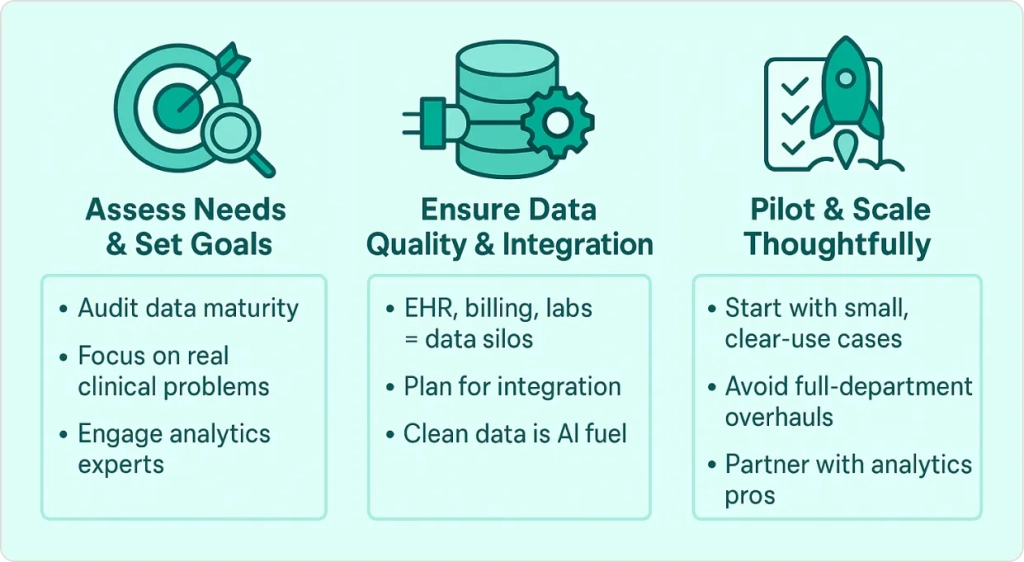
Assess Needs and Set Goals
Successful AI implementation begins with understanding your organization’s specific challenges and opportunities rather than chasing the latest technology trends.
Conduct a data maturity assessment to understand your current capabilities. Many organizations discover they need to address basic data quality and integration issues before advanced AI becomes viable.
Identify high-impact use cases by focusing on areas where AI can solve real problems. Common starting points include reducing administrative burden, improving patient flow, or enhancing clinical decision support for common conditions.
Engaging with healthcare analytics experts to audit your data infrastructure and workflows can help you develop a custom AI strategy aligned to your specific needs, whether you’re a hospital system, clinic, or healthcare technology company.
Ensure Data Quality and Integration
Clean, accessible data forms the foundation of any successful AI implementation in healthcare analytics.
Data integration often represents the biggest technical hurdle. Healthcare organizations typically have data scattered across electronic health records, billing systems, laboratory systems, imaging platforms, and other applications. Creating unified datasets requires careful planning and often significant technical investment.
Start with Pilot Projects and Scale Thoughtfully
Choose manageable scope for initial projects. Rather than attempting to transform entire departments, focus on specific workflows or decision points where AI can demonstrate clear value quickly.
Partner with Experts: In my experience, healthcare organizations don’t have to go it alone—partnering with firms that offer AI-driven healthcare analytics services can provide ready-made expertise and tools, speeding up the transformation while ensuring best practices are followed.
I’ve seen too many organizations struggle with AI implementations because they underestimated the complexity of healthcare workflows. Working with specialists who understand both the technology and clinical requirements dramatically improves success rates.
The Future of Healthcare with AI
Generative AI represents the next frontier in healthcare applications. Large language models could soon draft clinical guidelines, answer patient questions with remarkable empathy, and help medical students learn through interactive simulations.
Digital therapeutics combine AI with evidence-based interventions to treat medical conditions directly. These software-based treatments are earning FDA approval for conditions ranging from substance abuse to ADHD, representing an entirely new category of medicine.
The most exciting developments will emerge at the intersection of AI and human expertise. Healthcare will always be fundamentally about human relationships—the trust between patients and providers, the empathy that guides difficult conversations, and the wisdom that comes from years of clinical experience.
AI amplifies these human capabilities rather than replacing them. From my observations across dozens of implementations, the best outcomes arise when sophisticated algorithms support skilled professionals who understand their patients as whole people, not just data points.
The transformation is happening now. Healthcare organizations that embrace AI thoughtfully—with appropriate attention to privacy, ethics, and workflow integration—will lead the way to better outcomes for all.
Conclusion: Transform Your Healthcare Organization with Data and AI
Healthcare data analytics and AI represent the most significant advancement in medical care since the development of modern pharmaceuticals. As we’ve explored throughout this guide, these technologies are already delivering measurable improvements in patient outcomes, operational efficiency, and cost management across healthcare organizations worldwide.
Key takeaways from this transformation include:
- Predictive analytics in healthcare enables proactive care by identifying at-risk patients 24-48 hours before traditional methods
- AI in healthcare is achieving diagnostic accuracy that matches or exceeds human specialists in many applications
- Healthcare analytics streamlines operations, reducing administrative burden by up to 60% while improving resource allocation
- Custom AI solutions for healthcare are delivering ROI through reduced readmissions, optimized staffing, and enhanced patient satisfaction
The evidence is clear: healthcare organizations implementing AI-driven analytics are not just improving their bottom line—they’re saving lives, reducing suffering, and creating more sustainable healthcare systems for the future.
But success requires more than just adopting new technology. It demands thoughtful planning, proper data infrastructure, and expert guidance to navigate the complex intersection of healthcare regulations, clinical workflows, and advanced analytics.
Are you ready to transform your healthcare organization with data and AI?
SR Analytics specializes in AI-driven healthcare analytics solutions that deliver measurable improvements in patient care and operational efficiency. Our proven expertise in healthcare data integration, predictive analytics, and AI implementation helps organizations transform complex challenges into clear business advantages.
From building custom AI solutions for healthcare to modernizing legacy systems, we provide the technical expertise and strategic guidance you need to succeed in the data-driven healthcare revolution.



